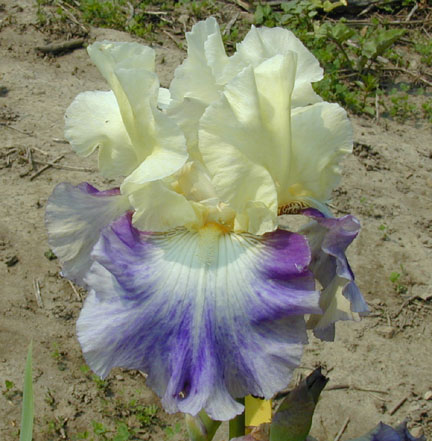This is a public-interest archive. Personal data is pseudonymized and retained under
GDPR Article 89.
RE: Analysis of MS seedlings -Flavanoid?
- Subject: [PHOTO] [iris-photos] RE: Analysis of MS seedlings -Flavanoid?
- From: i*@netscape.net
- Date: Tue, 18 Jan 2005 10:24:41 -0500
Chuck,
I thought your illustration on carotenes was quite clear. I had wondered
about whether Flights of Fancy was tttt because the beards didn?t look
tangerine in some of the photos I've taken. Its my understanding that the
beard color is expressed in three layers much like the fall petal. I was
curious whether FOF could be tttt in the layer on the tip of the beard, but
not the other layers. The description in the registration states that it is:
white to cream tipped flame.
Hoping this doesn't just muddy the waters
Robin Shadlow
zone 5 NE
Thanks for your Question. I’ve been waiting for it. Sometimes the answer
doesn’t make sense until the right question is asked. Actually you have two
good questions here.
The one about beard structure is one I’ve asked but have no answers to. I
haven’t come across any information on the beard’s structure. There are
papillae on the surface of the falls on many bearded iris and they can vary
in height. The beard may be an extreme form of this. Thus it could be two
layers of the cell wall of the upper dermis or it could also have some of the
vacuole in the centre. Also it could be some other modification of the upper
dermis cells. It would be useful to know.
The question of the colour of the standards is the one I have some better
ideas on. Take a close look at the standards of FoF and seedling #4 and
compare them to the standards of Seakist (attached) They look the same to me,
although you have to look past the anthocyanin intrusions/wash in FoF. I
have extracted a water based yellow pigment from the standards of Seakist but
there is no oil based yellow there.This would appear to be a flavanoid but I
haven’t identified it. There are a couple of suspects based on what has
been found in other, (not iris) flowers. Without this pigment FoF would have
a white rather then a cream ground.
For now, use the assumption that FoF is reduced carotenoid for all the
genetic analysis. We can see how this fits.
As to the flavanoid (assumed to be pending better identification) we can see
it as possibly being in seedlings #1, 4, 12, 14 & 16. We do have to discount
the colour perception induced by anthocyanin intrusions/wash. It is also
possible that the flavanoid is present in a number of the seedlings with
yellow. I have extracted this water based yellow from a few other iris
flowers that have both this flavanoid and a carotene. Harvest of Memories is
one example. Thus we have 5 and possibly 8 ( #8 could have both lycopene and
flavanoid). This can fit with a dominant gene showing 50% in a cross. It can
also fit with a four dosage recessive X 3 dosage recessive. the other
recessive option to consider would be 4 recessive X 2 recessive. This would
give 1/6 offspring showing four recessives . This would give a prediction of
3 of this type in this cross. As we are looking at 5 minium then this is not
the best fit to the data.
Here is a good time to do some kitchen chemistry on FoF and the seedlings
with yellow. Take the petals, cut off the obvious portions of anthocyanin (
not essential) and extract through a thorough mashing in methyl Hydrate (
paint thinner) or rubbing alcohol. A mortar and pestle would be handy here.
Then filter the extract. A coffee filter works well. Then add some clear oil
( lamp oil, baby oil or mineral oil all work, cooking oil usually has some
tinting so don’t use it). Then shake well and then let settle. A test tube
works well for this or any narrow jar. The oil rises to the top and takes any
oil based pigments with it. Any yellow pigment left in the bottom is a water
based pigment. Any anthocyanin that gets in the alcohol segment will
deteriorate rather quickly and will be gone in a day or two. The flavanoid
remains. I just checked my extract from Seakist and its still there 6 months
later so its very stable. This can tell us what seedlings have this pigment
and help sort out the genetics.
I would suspect the flavanoid to be a dominant gene.
I really really would like some feedback re all this. Doesn’t it fit? Does
it seem real ? As this is a new concept I need to know what holes are there
so they can be explored/explained.
Chuck Chapman
__________________________________________________________________
Switch to Netscape Internet Service.
As low as $9.95 a month -- Sign up today at http://isp.netscape.com/register
Netscape. Just the Net You Need.
New! Netscape Toolbar for Internet Explorer
Search from anywhere on the Web and block those annoying pop-ups.
Download now at http://channels.netscape.com/ns/search/install.jsp
------------------------ Yahoo! Groups Sponsor --------------------~-->
In low income neighborhoods, 84% do not own computers.
At Network for Good, help bridge the Digital Divide!
http://us.click.yahoo.com/EA3HyD/3MnJAA/79vVAA/2gGylB/TM
--------------------------------------------------------------------~->
Yahoo! Groups Links
<*> To visit your group on the web, go to:
http://groups.yahoo.com/group/iris-photos/
<*> To unsubscribe from this group, send an email to:
iris-photos-unsubscribe@yahoogroups.com
<*> Your use of Yahoo! Groups is subject to:
http://docs.yahoo.com/info/terms/

Other Mailing lists |
Author Index |
Date Index |
Subject Index |
Thread Index


